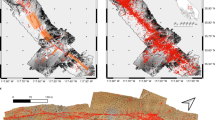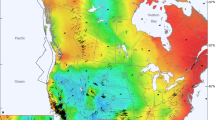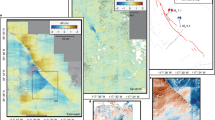Abstract
Knowledge of the stress field in the Earth's crust is crucial for the understanding of processes such as faulting and fracturing. It is also of fundamental importance for the design and construction of underground structures. The two most common methods used for in situ stress determinations for engineering geology purposes are (1) the stress relief method, in which the differences in strain resulting from induced stress relaxation are studied, and (2) the hydraulic fracturing method, in which one of the presumed principal stresses is replaced by a hydraulic pressure. Of these, the stress relief method is more applicable to design and construction problems as it enables the three-dimensional stress tensor to be measured. The in situ rock stress measurements reported here were carried out in a 500-m deep borehole in Precambrian bedrocks in Sweden and show high stress levels throughout the rock mass. A comparison between the actual recorded stresses and the theoretical stress field from a 2,000 m-thick land ice may provide a possible explanation for the measured stress situation.
This is a preview of subscription content, access via your institution
Access options
Subscribe to this journal
Receive 51 print issues and online access
$199.00 per year
only $3.90 per issue
Buy this article
- Purchase on Springer Link
- Instant access to full article PDF
Prices may be subject to local taxes which are calculated during checkout
Similar content being viewed by others
References
Hiltscher, R., Martna, J. & Strindell, L. Proc. 4th int. Congr. Rock Mech. 2, 227–234 (1979).
Voight, B. Proc. 1st int. Congr. Rock Mech. 2, 45–50 (1966).
Jamison, O. B. & Cook, N. G. W. J. geophys. Res. 85, B4 1833–1838 (1980).
Carlsson, A. & Olsson, T. Swedish State Power Board, Research and Development Rep. 5:1 (1982).
Author information
Authors and Affiliations
Rights and permissions
About this article
Cite this article
Carlsson, A., Olsson, T. High rock stresses as a consequence of glaciation. Nature 298, 739–742 (1982). https://doi.org/10.1038/298739a0
Received:
Accepted:
Issue Date:
DOI: https://doi.org/10.1038/298739a0
This article is cited by
-
The geology of nuclear waste disposal
Nature (1984)
Comments
By submitting a comment you agree to abide by our Terms and Community Guidelines. If you find something abusive or that does not comply with our terms or guidelines please flag it as inappropriate.



